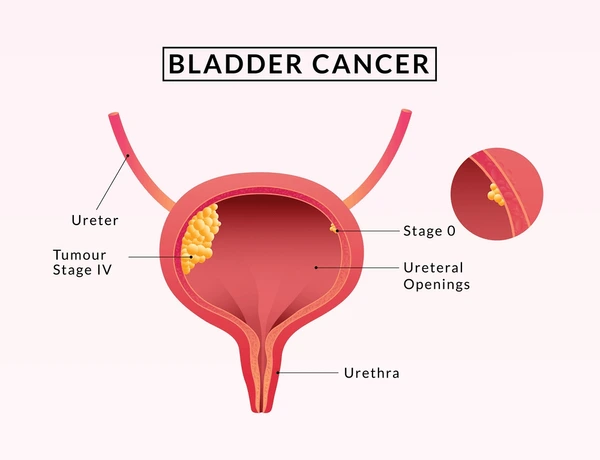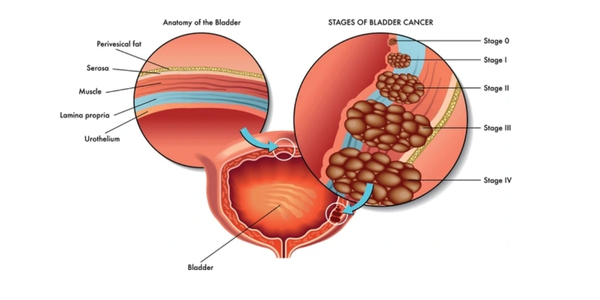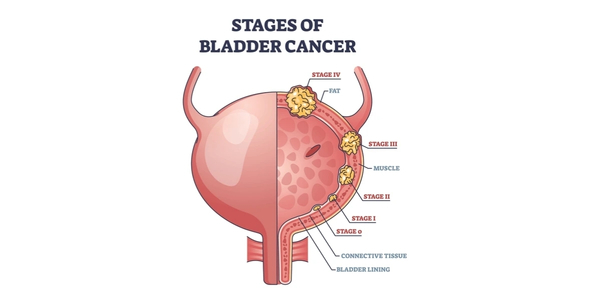Dr. Nitin Singhal
Urinary Bladder Cancer
What is Bladder Cancer?
Bladder cancer begins in the cells of the bladder, which is the organ that holds urine in your body. The cancer starts in the cells lining the inside of the bladder, which is why it’s most often called Urothelial Carcinoma.
This type of cancer can develop in many sections of the bladder and, if left untreated, may spread to other parts of the body, including local lymph nodes or distant organs such as the liver or bones.

Your Guide to Bladder Cancer
-Chronic bladder infections or stones
-Lack of Exercise
-Smoking
-Exposure to Chemicals
-Arsenic in Drinking Water
-Family History or Genetics
Early stages often show no signs, but as the disease progresses, symptoms may include:
-Blood in urine (hematuria)
-Frequent urination
-Painful urination
-Back pain or discomfort in the pelvis
-Feeling very tired or weak for no clear reason.
Treatment depends on the stage and location of the tumor. Options include:
-Robotic-Assisted Surgery
-Immunotherapy
-Chemotherapy
-Radiation Therapy
Urothelial Carcinoma (Transitional Cell Carcinoma):
-Starts in the cells lining the inside of the bladder.
-Most common type of bladder cancer (about 90% of cases).
-Often linked to smoking and chemical exposure.
Squamous Cell Carcinoma:
-Develops from long-term irritation or inflammation of the bladder (like from infections or catheters).
-More common in places where people have frequent bladder infections (like some parts of Africa and the Middle East).
-Less common but usually more aggressive.
What is Robotic Surgery for Bladder Cancer?
Robotic Surgery for Bladder Cancer is a new, minimally invasive method of removing bladder cancer with advanced robotic equipment.
The surgeon uses a console to control robotic arms, allowing him to perform surgery with tiny cuts. This results in more precision, less discomfort, less bleeding, and a faster recovery time than standard open surgery.
It’s especially helpful for complex bladder surgeries, including complete or partial bladder removal and reconstruction. It allows surgeons to remove the cancer with high accuracy while preserving as much healthy tissue and function as possible.

Why Robotic Surgery?

Faster Recovery Time

Low Risk of Infection

Lesser Scars

Less Discomfort After Surgery

Shorter Hospital Stay

Speedier Return to Daily Life
Why Dr. Nitin Singhal for Robotic Bladder Cancer Surgery?
Dr. Nitin Singhal is one of India’s trusted names in Robotic Bladder Cancer Surgery, known for his expertise, precision, and compassionate approach to care.
He specializes in complicated bladder cancer cases, using modern robotic procedures to reduce pain, shorten hospital stays, and increase recovery time. His priority is always to remove cancer properly while maintaining quality of life, whether it’s a partial bladder removal, radical cystectomy, or bladder reconstruction such as a neobladder.

Commonly Asked Questions
Bladder cancer can be life-threatening, especially if it spreads. However, with early detection and proper treatment, many patients live normal lives post-treatment, especially with early-stage cancer.
If the entire bladder needs removal (cystectomy), a new method for urine storage (like a neobladder or ileal conduit) will be created, but surgeons aim to preserve bladder function where possible.
Yes, robotic surgery is safe when performed by experienced surgeons and is associated with better outcomes and fewer complications compared to traditional surgery.
If the cancer is detected early and surgically removed, robotic surgery can offer a good chance of cure. Follow-up care and monitoring are crucial for detecting any recurrence.
A Visual Guide


Discover How Robotic Cancer Surgery can Change Your Recovery Journey.
